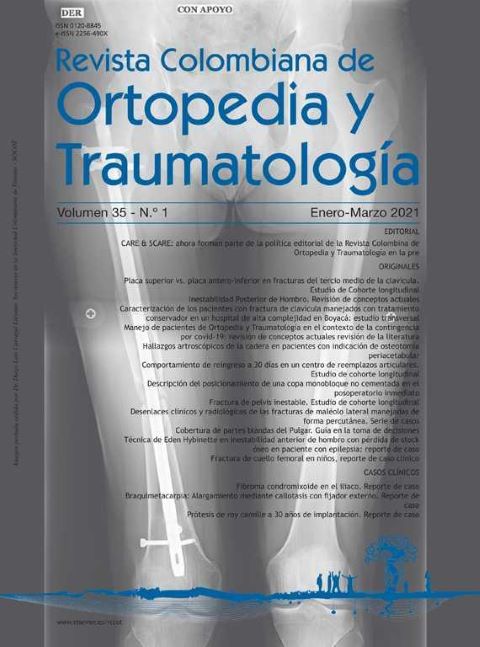Descripción del posicionamiento de una copa monobloque no cementada en el posoperatorio inmediato
DOI:
https://doi.org/10.1016/j.rccot.2020.10.005Palabras clave:
prótesis de cadera, osteoartrosis de la cadera, artroplastia de reemplazo de cadera, posicionamiento de la copa acetabularResumen
Introducción: El posicionamiento adecuado de la copa acetabular en el reemplazo total de cadera (RTC) puede mejorar la función, reducir el desgaste, el pinzamiento y la luxación. La posición de la copa se describe como la relación espacial entre el centro de rotación de la cadera y la pelvis. El objetivo de este estudio es describir el posicionamiento de una copa monobloque no cementada en el posoperatorio inmediato de los pacientes a quienes se les realizo un RTC primario.Materiales y Métodos: Estudio observacional descriptivo, los pacientes fueron operados por 4 cirujanos especialistas en cirugía de reemplazo articular de cadera en 8 clínicas, los procedimientos se realizaron entre octubre de 2015 a agosto de 2018, las medidas radiológicas fueron la inclinación, anteversión, lateralización, porcentaje de descubrimiento y espacio detrás de la copa acetabular.
Resultados: Los mayores porcentajes son para las copas acetabulares con inclinación de 36 a 48 grados, anteversión de 5 a 15 grados, lateralización de -2 a +2 mm, porcentaje de descubrimiento del 0% y espacio detrás de la copa de 0 a 3 mm.
Discusión: Diferentes autores han identificado zonas seguras de implantación las cuales concuerdan con los resultados de nuestro estudio. El posicionamiento adecuado de la copa acetabular monobloque no cementada se pudo lograr con una correcta indicación del implante, un abordaje quirúrgico que permitió una ubicación tridimensional idónea y un acetábulo sin alteraciones anatómicas a nivel periférico.
Nivel de Evidencia: III
Descargas
Referencias bibliográficas
Scheerlinck T. Cup positioning in total hip arthroplasty. Acta Orthop Belg. 2014;80:336-47.
Lewinnek GE, Lewis JL, Tarr R, Compere CL, Zimmerman JR. Dislocations after total hipreplacement arthroplasties. J Bone Joint Surg Am. 1978;60:217-20. https://doi.org/10.2106/00004623-197860020-00014
Higa M, Tanino H, Abo M, Kakunai S, Banks SA. Effect of acetabular component anteversion on dislocation mechanisms in total hip arthroplasty. J Biomech. 2011;44:1810-3. https://doi.org/10.1016/j.jbiomech.2011.04.002
Callanan MC, Jarrett B, Bragdon CR, Zurakowski D, Rubash HE, Freiberg AA, et al. The John Charnley Award: risk factors for cup malpositioning: quality improvement through a joint registry at a tertiary hospital. Clin Orthop Relat Res. 2011;469:319-29. https://doi.org/10.1007/s11999-010-1487-1
Eilander W, Harris SJ, Henkus HE, Cobb JP, Hogervorst T. Functional acetabular component position with supine total hip replacement. Bone Joint J. 2013;95-B:1326-31. https://doi.org/10.1302/0301-620X.95B10.31446
Seagrave KG, Troelsen A, Malchau H, Husted H, Gromov K. Acetabular cup position and risk of dislocation in primary total hip arthroplasty. Acta Orthop. 2017;88:10-7. https://doi.org/10.1080/17453674.2016.1251255
Northgate Public Services. ODEP - Orthopaedic Data Evaluation Panel [Internet]. 2002. Available from: http://www.odep.org.uk/products.aspx?typeid=2.
Espinosa-Ruiz A, Zorrilla-Ribot P, Salido-Valle JA. Recambio de polietileno mediante la cementación de un nuevo componente sobre el metal-back osteointegrado. Rev Esp Cir Ortop Traumatol. 2015;59:14-8, https://doi.org/10.1016/j.recot.2014.07.006
Sumner DR. Long-term implant fixation and stress-shielding in total hip replacement. J Biomech. 2015;48:797-800, https://doi.org/10.1016/j.jbiomech.2014.12.021
Young AM, Sychterz CJ, Hopper RHJ, Engh CA. Effect of acetabular modularity on polyethylene wear and osteolysis in total hip arthroplasty. J Bone Joint Surg Am. 2002;84:58-63. https://doi.org/10.2106/00004623-200201000-00009
Mueller LA, Schmidt R, Ehrmann C, Nowak TE, Kress A, Forst R, et al. Modes of periacetabular load transfer to cortical and cancellous bone after cemented versus uncemented total hip arthroplasty: A prospective study using computed tomography- assisted osteodensitometry. J Orthop Res. 2009;27:176-82. https://doi.org/10.1002/jor.20742
Judas FMJ, Dias RF, Lucas FM. A technique to remove a well-fixed titanium-coated RM acetabular cup in revision hip arthroplasty. J Orthop Surg Res. 2011;6:31. https://doi.org/10.1186/1749-799X-6-31
Lafon L, Moubarak H, Druon J, Rosset P. Cementless RM Pressfit® Cup. A clinical and radiological study of 91 cases with at least four years follow-up. Orthop Traumatol Surg Res. 2014;100(4S):S225-9, https://doi.org/10.1016/j.otsr.2014.03.007
Wyatt M, Weidner J, Pfluger D, Beck M, The RM. pressfit vitamys: 5-year swiss experience of the first 100 cups. HIP Int. 2017;27:368-72, 14. https://doi.org/10.5301/hipint.5000469
Hooper N, Sargeant H, Frampton C, Hooper G. Does a Titanium- coated Polyethylene Press- fit Cup Give Reliable Midterm Results? Clin Orthop Relat Res. 2015;473:3806-10. https://doi.org/10.1007/s11999-015-4556-7
Erivan R, Eymond G, Villatte G, Mulliez A, Myriam G, Descamps S, et al. RM Pressfit(R) cup: good preliminary results at 5 to 8 years follow-up for 189 patients. Hip Int. 2016;26:386-91. https://doi.org/10.5301/hipint.5000359
European Commission. European Guidelines on Quality Criteria for Diagnostic Radiographic Images. Eur 16260 En. 1996. 71 p.
Bachhal V, Jindal N, Saini G, Sament R, Kumar V, Chouhan D, et al. A new method of measuring acetabular cup anteversion on simulated radiographs. Int Orthop. 2012;36:1813-8. https://doi.org/10.1007/s00264-012-1583-9
García SE, Barragán JH, Narváez JA, Carrillo Bayona JA. Valoración radiológica de las artroplastías. Rev colomb radiol. 2008;19:2454-60.
Biedermann R, Tonin A, Krismer M, Rachbauer F, Eibl G, Stockl B. Reducing the risk of dislocation after total hip arthroplasty: the effect of orientation of the acetabular component. J Bone Joint Surg Br. 2005;87:762-9. https://doi.org/10.1302/0301-620X.87B6.14745
Grammatopoulos G, Thomas GER, Pandit H, Beard DJ, Gill HS, Murray DW. The effect of orientation of the acetabular component on outcome following total hip arthroplasty with small diameter hard-on-soft bearings. Bone Joint J. 2015;97-B:164-72. https://doi.org/10.1302/0301-620X.97B2.34294
Danoff JR, Bobman JT, Cunn G, Murtaugh T, Gorroochurn P, Geller JA, et al. Redefining the Acetabular Component Safe Zone for Posterior Approach Total Hip Arthroplasty. J Arthroplasty. 2016;31:506-11, 15. https://doi.org/10.1016/j.arth.2015.09.010
Garcia-Rey E, Garcia-Cimbrelo E. Abductor Biomechanics Clinically Impact the Total Hip Arthroplasty Dislocation Rate: A Prospective Long-Term Study. J Arthroplasty. 2016;31: 484-90. https://doi.org/10.1016/j.arth.2015.09.039
Halma JJ, Eshuis R, Vogely HC, van Gaalen SM, de Gast A. An uncemented iso-elastic monoblock acetabular component: preliminary results. J Arthroplasty. 2015;30:615-21. https://doi.org/10.1016/j.arth.2014.11.017
Kim Y-H, Choi Y. Kim J-S. Influence of patient-, design- , and surgery-related factors on rate of dislocation after primary cementless total hip arthroplasty. J Arthroplasty. 2009;24:1258-63. https://doi.org/10.1016/j.arth.2009.03.017
Erivan R, Aubret S, Villatte G, Mulliez A, Descamps S, Boisgard S. Does using a polyethylene RM press-fit cup modify the preparation of the acetabulum and acetabular offset in primary hip arthroplasty? Orthop Traumatol Surg Res. 2017;103: 669-74. https://doi.org/10.1016/j.otsr.2017.03.026
Esposito CI, Gladnick BP, Lee Y-Y, Lyman S, Wright TM, Mayman DJ, et al. Cup position alone does not predict risk of dislocation after hip arthroplasty. J Arthroplasty. 2015;30:109-13. https://doi.org/10.1016/j.arth.2014.07.009
Grammatopoulos G, Dhaliwal K, Pradhan R, Parker SJM, Lynch K, Marshall R, et al. Does lumbar arthrodesis compromise outcome of total hip arthroplasty? Hip Int. 2019;29:496-503. https://doi.org/10.1177/1120700018793373
Bicanic G, Delimar D, Delimar M, Pecina M. Influence of the acetabular cup position on hip load during arthroplasty in hip dysplasia. Int Orthop. 2009;33:397-402. https://doi.org/10.1007/s00264-008-0683-z









